Part 3: How to Design a Kitchen - Finishing Touches and Detailed Designing
Welcome to the last part of our kitchen design series - merging functionality with personal touch.
In Part 3, we'll tackle how to add elements that not only serve your cooking needs but also reflect your personal style and way of living.
In Part 2, we discussed practical design and functionality. Now, we move on to the final touches that make your kitchen truly unique. This is an opportunity for creativity and personal expression. Everything from your choice of lighting to your choice of fixtures can reflect your personal style.
We'll discuss how to pick the right lighting, choose kitchen fixtures that fit well with your cabinets, and add decorations that make your kitchen vibrant and friendly. Also, we'll talk about the key role of textiles and soft furnishings for comfort, texture, and colour.
Let's dive into the last part where every tiny detail matters. They all blend to create not just a functional kitchen, but a space that you'll love and find inspiration in every day.
Selecting the Perfect Lighting
Good lighting can change your kitchen from just being useful to something truly amazing. It can help your kitchen work well and look great. Let's look at how to get the best lighting in your kitchen.
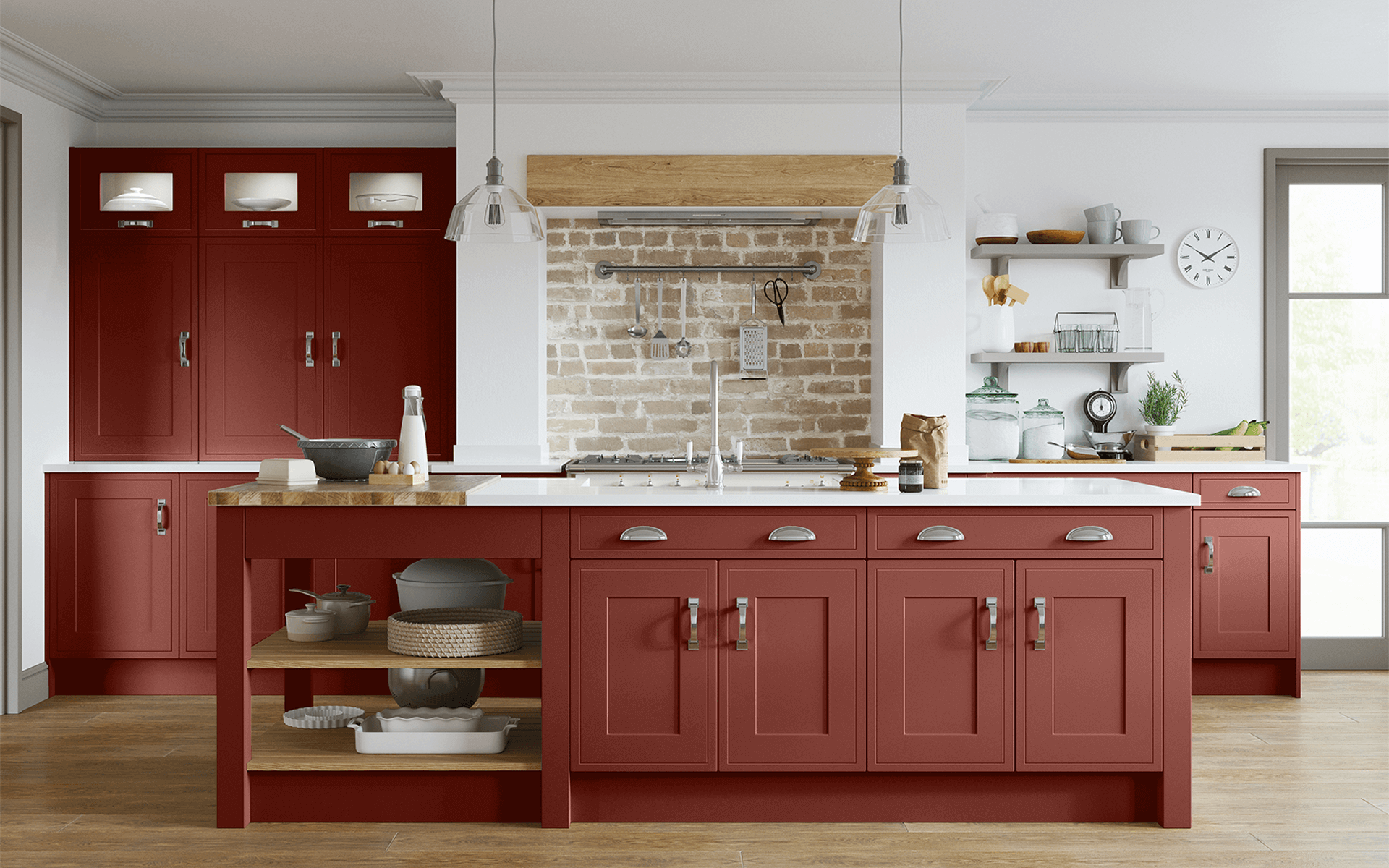
Layering Different Types of Lighting:
-
Main Lighting: This is your kitchen's basic lighting, typically coming from fixtures on the ceiling. It should give enough light without being too harsh. Think about using inbuilt lights or a main hanging light.
-
Task Lighting: This type of lighting is key for carrying out particular tasks. It incorporates lights placed under cabinets or hanging above islands and countertops. Task lighting should provide sufficient brightness to avoid damage to the eyes, but it needs to blend well with the kitchen's overall look.
-
Accent Lighting: This type of lighting is used to emphasise design features or decorations. It could be lights above kitchen cabinets, small lights close to the floor, or focused lights on wall art. Accent lighting makes your kitchen look more engaging and welcoming.
Lighting as a Design Element:
-
Style Compatibility: Choose light fixtures that match your kitchen's style. For a modern kitchen, pick simple, clean designs. For traditional or rustic kitchens, more decorative fixtures may fit better.
-
Focal Points with Lighting: A standout item, such as a distinct pendant light hanging over the kitchen island, can act as a focal point. It provides more than just illumination, adding a significant design touch to your kitchen.
-
Harmony and Balance: Make sure your kitchen's lighting matches with the rest of the elements. The materials, colours, and finishes of your lights should complement your cabinets, fittings, and appliances for a unified appearance.
Picking and arranging various lighting forms can help make your kitchen bright, usable, and visually appealing. The right lighting not only lights up your kitchen but also enhances its overall kitchen design.
Choosing Hardware and Fixtures
Choosing the right hardware and fixtures in your kitchen is important. They may look like small details, but they can greatly impact the design of your kitchen. Let's look at how to pick the best cabinet hardware and sink and faucet styles for your kitchen.
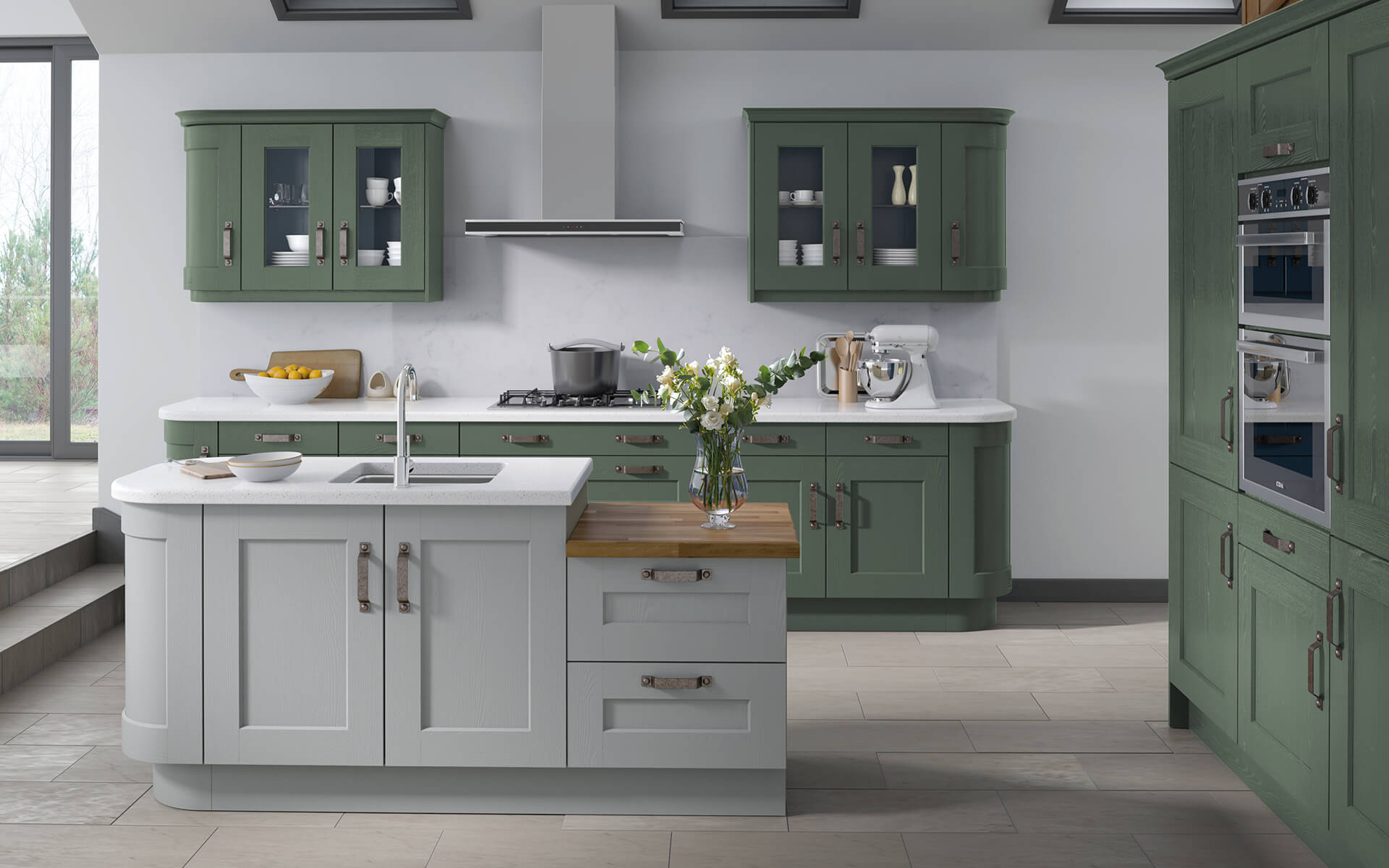
Cabinet Hardware:
Kitchen design significantly benefits from the practical and visual appeal of cabinet hardware.
Selecting Knobs and Pulls:
-
Match Kitchen Style: Your cabinet knobs and pulls should match your kitchen's look. For a modern kitchen, choose straightforward, sleek hardware in brushed nickel or chrome. For a more traditional kitchen, select detailed hardware in bronze or brass.
-
Combining Usefulness and Beauty: Besides looks, think about how practical the hardware is. Check that the knobs or pulls are easy to handle and match well with the kitchen door size and style.
-
Try Before You Buy: It's wise to experiment with a few choices before settling on a final decision. Many providers give samples you can test in your home kitchen to check how they match and fit.
Sink and Tap Styles:
Your kitchen's practicality and visual appeal can be greatly affected by your sink and tap choice, as they are key elements in perfectly balancing usefulness with design.
Aligning Fixtures with Kitchen Design:
- Cohesion in Design: Your sink and tap need to blend with your kitchen's overall design. For instance, a stainless-steel undermount sink might suit a modern kitchen look, while a farmhouse-style sink goes well with a rustic or country kitchen theme.
-
Material and Finish: The sink and tap's material and finish should match with the rest of the kitchen. This means you should think about the colour and finish of your appliances and cabinet hardware to create a uniform design.
-
Functional Considerations: Besides looks, consider practical factors. Do you require a double sink for doing multiple tasks, or would one, larger sink be enough? For taps, think about added features like pull-out sprayers or touch-free usage for added convenience.
Choosing hardware and fixtures that complement your kitchen's design helps add individuality and completes the look. Even though these parts are small, they play a key role in unifying your kitchen's design to create a harmonious and well-planned room.
Adding Decorative Elements
Adding decorative pieces to your kitchen isn't just about looks, it's a way to make the space reflect your own personal style. We'll discuss how things like wall decorations, colour features, open shelves, and decorative storage can make your kitchen more appealing and unique.
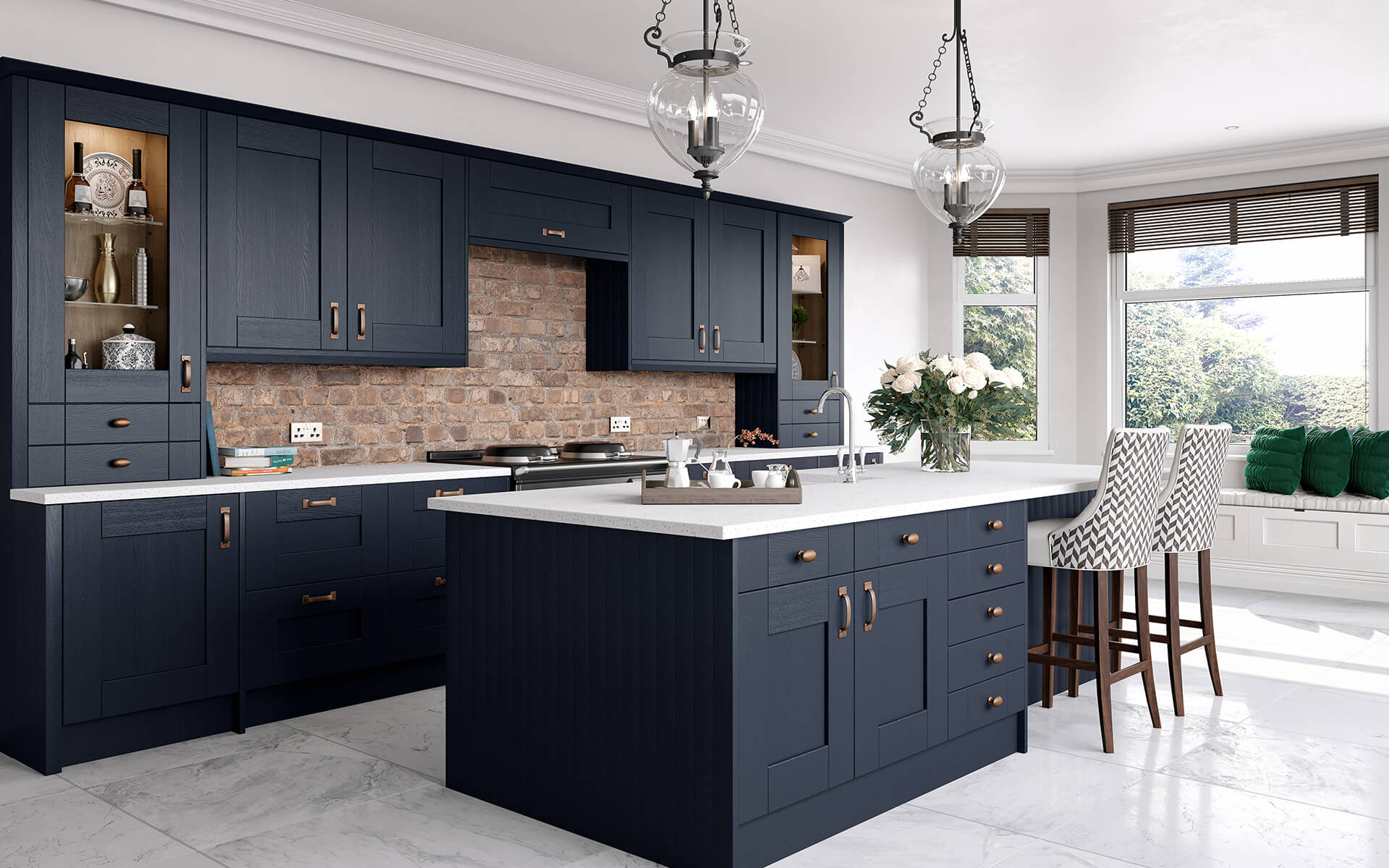
Wall Décor and Colour Accents:
Wall Décor and Colour Accents are a great way to add a unique touch to your kitchen. You can use them to introduce interesting colours, patterns, and textures.
Using Paint, Tiles, or Artwork:
-
Paint for a Quick Change: Applying new paint can quickly alter your kitchen's appearance. Use bright colours for a standout effect or subtle shades for a relaxed ambience. Accent walls can provide additional depth and charm to the space.
-
Using Tiles for Added Effect: Decorative tiles can enhance your kitchen's look. Consider mosaic patterns, artistic designs, or trendy geometric shapes to add interest to your kitchen walls.
-
Art as an Expression: Artwork can give your kitchen a personal touch. Be it modern prints, traditional paintings, or family photos, they should show your style and match the kitchen's colours and design.
-
Gallery Wall or Focal Art Piece: Consider using several small artworks to create a gallery wall or pick one large, prominent piece as a central point. Remember, it's essential to harmonise your art with the room's other design elements.
Open Shelving and Decorative Storage:
Open shelving and decorative storage blend usefulness with style, ensuring a tidy kitchen that also allows for personal taste and decorative touches.
Stylishly Displaying Kitchenware:
- Use Open Shelving for Convenience and Showcasing: Open shelves offer both easy reach to commonly used things and a great way to display ornaments, recipe books, or beautiful dish sets
- Combining Practicality and Beauty: Organise things on open shelves in a thoughtful way. Blend items like spice jars or plates with decorative pieces or plants. This way, it looks good and is practical.
Creative Decorative Storage:
- Turning Storage into Décor: View your storage options as decorative items. Things like wicker baskets, fancy jars, and interesting spice holders can add to your kitchen's look while also being functional.
- Custom Solutions: Think about personalised storage ideas like integrated wine racks or cabinets with glass doors to show off your best china. These features can double as decoration while also helping to keep your stuff tidy and within easy reach.
Decorative elements turn your kitchen from a simply useful area into a space that genuinely speaks your personal style. It's about fostering an inviting room where each detail adds to your home's charm and warmth.
Incorporating Textiles and Soft Furnishings
Textiles and soft furnishings can add layers of texture, colour, and comfort to your kitchen, transforming it into a more welcoming and homely space. Let’s delve into how window treatments and floor textiles can enhance the overall feel of your kitchen.
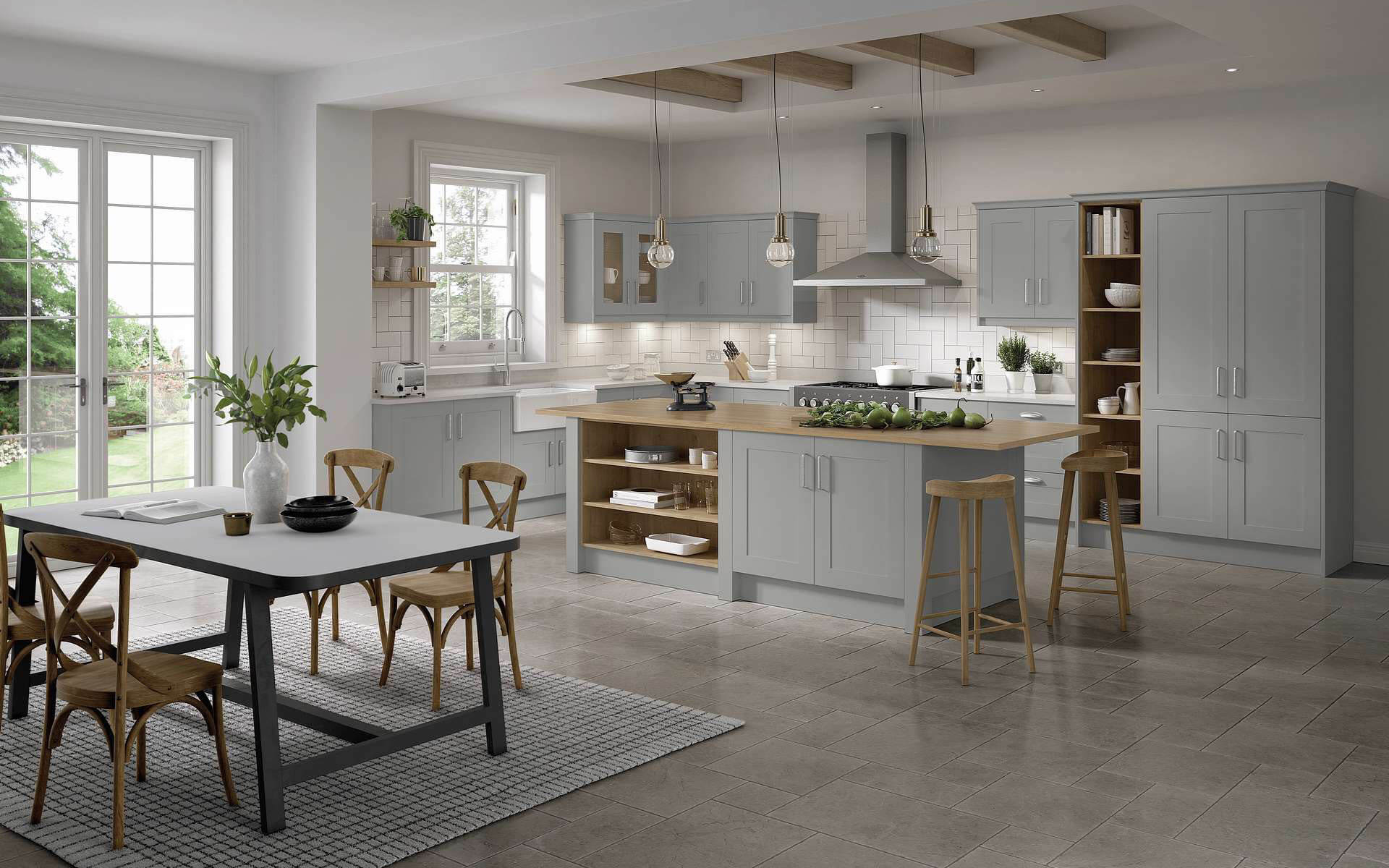
Window Treatments:
Kitchen window treatments are for more than just light and privacy control, they're also a way to add style and complement the room's design.
Choosing the Right Style:
-
Blinds, Curtains, and Shades: Choose a style that matches your kitchen's look. Venetian blinds give a neat, updated appearance, while curtains bring a feeling of comfort and warmth. Roman shades are great for all kitchen styles, from old-fashioned to modern.
-
Functionality and Fabric: Pick window treatments that are simple to clean and can handle damp conditions, as this suits a kitchen environment. Also, ensure that the fabric's colours and styles blend with the kitchen.
Enhancing Natural Light:
- Light and Airy Fabrics: Choose light or transparent fabrics to allow more natural light in, while still maintaining privacy. This can help your kitchen feel brighter and more spacious, especially if it's small or doesn't get a lot of light.
- Layering for Adaptability: Combine blinds and curtains to better manage light and privacy. This method gives you flexibility to adjust lighting throughout the day.
Rugs and Mats:
Rugs and Mats can significantly improve the comfort and appearance of your kitchen. They not only provide a cosy feel but also add to the colour theme and design of the room.
Adding Comfort and Colour:
-
Comfort Under Your Feet: Using rugs and mats can make standing areas, such as the sink or stove, more comfortable.
-
Colour and Pattern: Opt for rugs or mats that add colour or design to your kitchen. They can provide a splash of colour in a simple kitchen or feature a design that fits in with the rest of the kitchen's style.
Practical Considerations:
-
Safety and Material: Choose mats or rugs that are non-slip and easy to clean. They should be tough and fit for frequently used kitchen spaces.
-
Placement Strategy: Use rugs to highlight different areas in your kitchen like a dining or preparation zone. This enhances the look and organisation of your space.
Seasonal Changes:
-
Adapting to the Seasons: Think about swapping textiles as the seasons change – use light materials and shades for spring and summer, then switch to warmer, deeper hues for autumn and winter. Doing this can help your kitchen stay vibrant and reflect the seasonal shifts.
Cushions for Chairs and Benches
Cushions can help improve the comfort and look of your kitchen seating. They're great for chairs or built-in benches, adding a touch of luxury and personal style to your kitchen.
Enhancing Comfort:
-
Chair Cushions: Cushions can make kitchen chairs much more comfortable, especially if you're sitting for a long time. Pick cushions with good padding that match with the chair's style.
-
Bench Seating: Cushions on built-in kitchen benches can boost comfort and also serve as a decorative touch. They help make the seating area cosy and inviting.
Style and Colour:
-
Aesthetic Appeal: Choose cushion materials and colours that complement your kitchen's design. Make sure the colours match with other kitchen features like curtains or wall décor for a balanced look.
-
Patterns and Textures: Cushions can help to introduce patterns, textures, or even a pop of colour. They can disrupt a monotone kitchen or add an unexpected element in a neutral space.
Practical Considerations:
-
Material and Durability: Choose hard-wearing fabrics that are easy to clean for kitchen cushions, since they're more prone to wear and tear and spills. Cushion covers that can be removed and machine-washed are a sensible decision.
-
Size and Fit: Make sure the cushions match the size of the chairs or bench. Cushions that are too large or small can move around, affecting comfort and looks.
Adding cushions to your kitchen seats can make the space more comfortable and stylish. It's easy to switch them out for a new look or special events.
Personalising Your Space
Adding personal touches to your kitchen is what truly transforms it from a standard cooking area into a space that reflects your personality and style. Here’s how you can infuse uniqueness into your kitchen through decorative choices and functional décor.
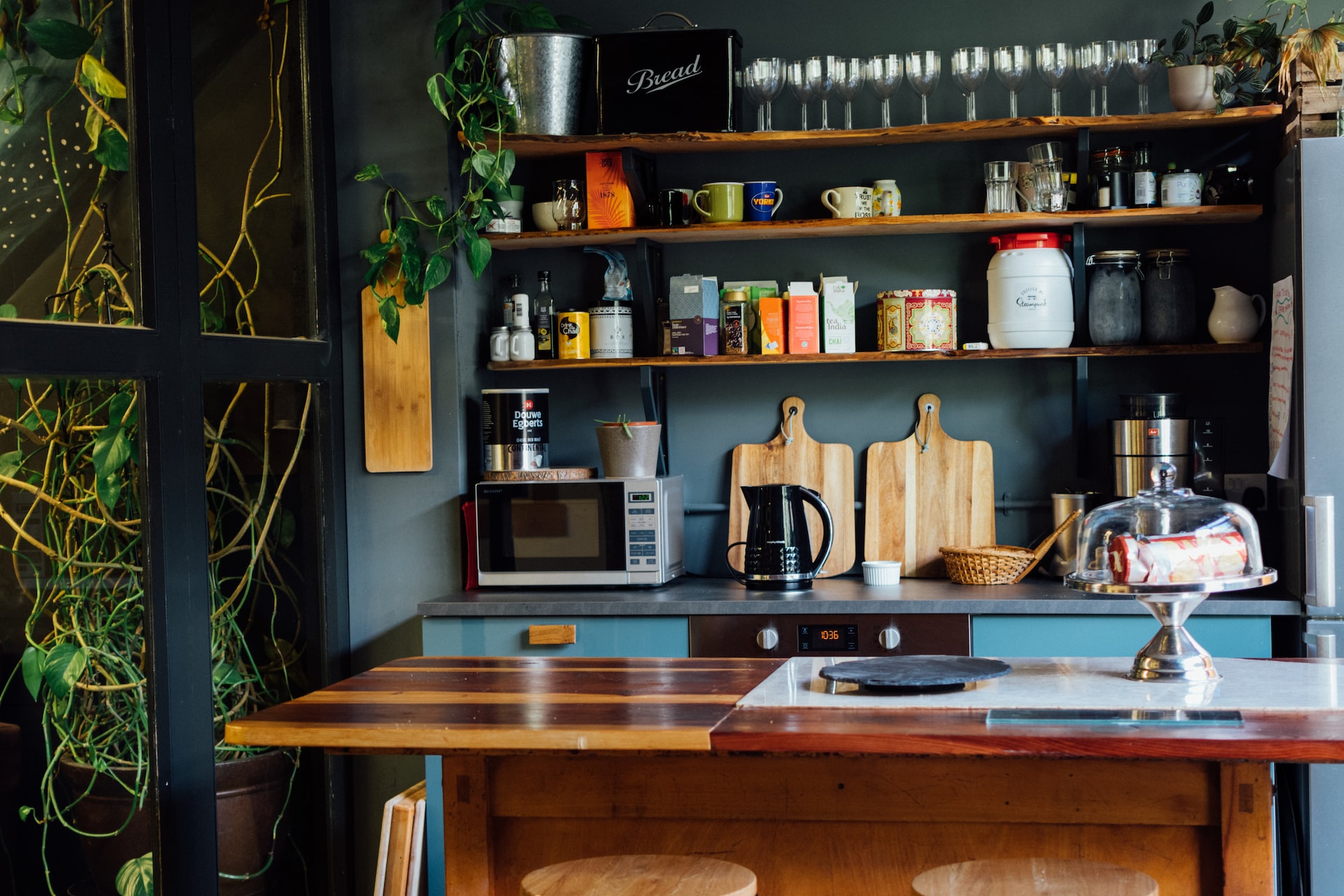
Unique Touches:
Adding unique elements into your kitchen design lets you personalise the space according to your own style and interests.
Reflecting Personal Style and Interests:
-
Display Collections: If you own collections like old-fashioned kitchenware, antique teapots, or unusual salt and pepper shakers, consider showcasing them. You can use open shelves or cabinets with glass doors for this purpose.
-
Incorporate Art and Photography: Add art or family pictures to your kitchen walls. You can frame favourite recipes, a beloved artwork, or create a photo wall with family moments for a more personal touch.
-
Themed Decorations: Choose a theme that you like. This could be a certain type of cuisine, a place you've travelled to, or your favourite colours. Incorporate this theme gently throughout your kitchen.
DIY Projects:
-
Handmade Items: Include DIY creations like a painted wall design or homemade light fixture for a truly unique and personal touch in your kitchen.
-
Upcycled Décor: Redecorate by reusing old furniture or kitchen items. A dresser or mason jars can be repurposed into a kitchen island or herb planters, respectively.
Functional Décor:
Functional Décor blends usefulness and attractiveness in the kitchen. Everyday items like spice racks or fruit bowls become both practical and decorative, enriching the kitchen's purpose and appeal.
Practical Items as Decorative Pieces:
-
Decorative Spice Racks: A good-looking spice rack is not only handy; it can also be a key feature. Pick one that matches your kitchen's style and makes it easy to find and grab your spices.
-
Stylish Fruit Bowls or Baskets: Choose a well-designed fruit bowl or basket to place on your kitchen table or island. It's useful and brings vibrant colours and vitality to the area.
Integrating Appliances and Tools:
-
Choose Good-Looking Appliances: Pick appliances that appeal to your eyes and represent your style. A classic looking toaster or a stylish coffee machine can double as décor.
-
Showing Off Your Kitchen Utensils: Place your attractive cooking tools, pots, and pans on a wall rack or over the island. This gives your kitchen an expert look and keeps these items within easy reach.
With these unique and practical décor items, your kitchen transforms from a simple place to cook, into a venue showcasing your personal style.
Conclusion
We're nearing the end of our in-depth guide on kitchen design. Let's look back at the various aspects we've discussed, which will come together to create your perfect kitchen.
In the first part, "Kitchen Planning and Conceptualisation," we began the kitchen design process.
We discussed important aspects of kitchen planning such as selecting a suitable layout, considering how to use the space, and choosing colours and materials. This stage helped establish a balance between a functional and aesthetically pleasing kitchen.
In Part 2, "Practical Kitchen Design Elements," we explored key areas of kitchen design.
We highlighted the need for precise measurements, choosing the right appliances, and creating storage solutions that boost ease of use and effectiveness.
This section converted your ideas into reality by ensuring your kitchen is both attractive and fully functional.
In Part 3, "Finishing Touches and Detailed Designing," we added the last touches to your kitchen. This involved discussing how lighting, hardware, and decorations can add character to the room.
We also discussed how textiles, soft furnishings, and personal touches can change a functional kitchen into a space that reflects your unique style and preferences.
This three-part guide covers all aspects of kitchen design, from big layout choices to tiny decorative details.
Designing your kitchen should be an enjoyable journey. Every decision you make is part of creating a space that's as enjoyable to cook in as it is a mirror of your personality. Your kitchen is more than just a room; it's a canvas for memories, a meeting spot, and a place that genuinely feels like home.
Ready to take your first steps - Book a FREE Design Consultation today
